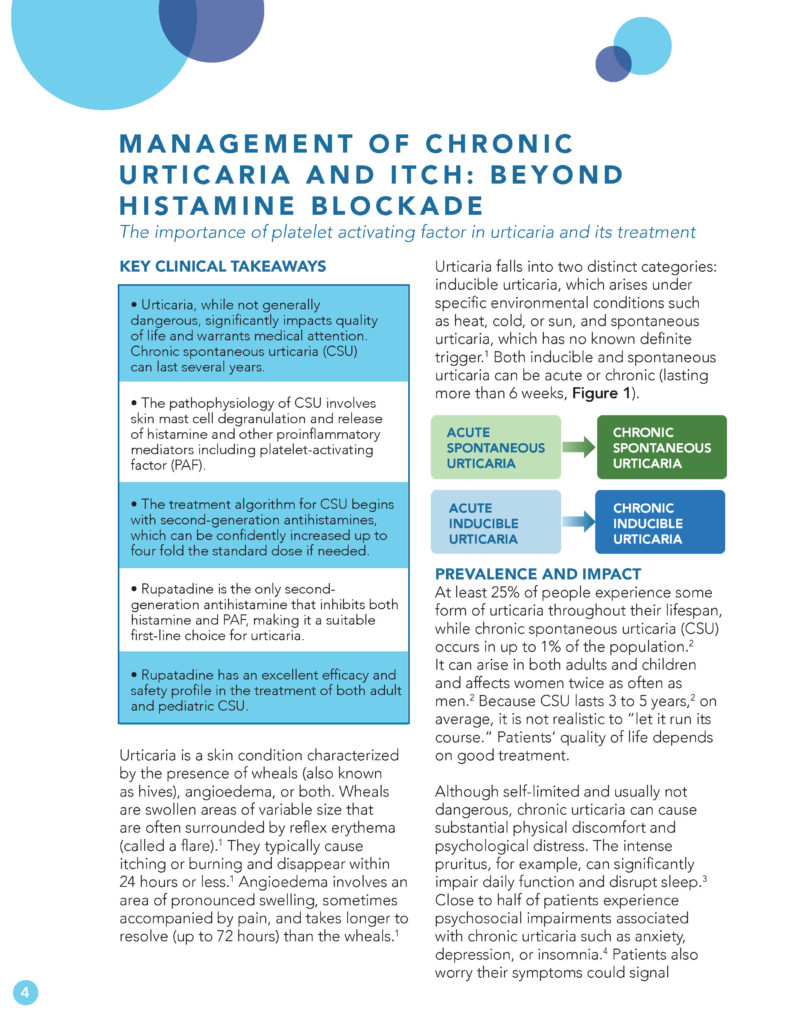Management of Chronic Urticaria and Itch: Beyond Histamine Blockade
The Importance of Platelet Activating Factor in Urticaria and its Treatment
DOI:
https://doi.org/10.58931/cait.2021.1s035Abstract
Urticaria is a skin condition characterized by the presence of wheals (also known as hives), angioedema, or both. Wheals are swollen areas of variable size that are often surrounded by reflex erythema (called a flare). They typically cause itching or burning and disappear within 24 hours or less. Angioedema involves an area of pronounced swelling, sometimes accompanied by pain, and takes longer to resolve (up to 72 hours) than the wheals.
- Urticaria, while not generally dangerous, significantly impacts quality of life and warrants medical attention. Chronic spontaneous urticaria (CSU) can last several years.
- The pathophysiology of CSU involves skin mast cell degranulation and release of histamine and other proinflammatory mediators including platelet-activating factor (PAF).
- The treatment algorithm for CSU begins with second-generation antihistamines, which can be confidently increased up to four-fold the standard dose if needed.
- Rupatadine is the only second-generation antihistamine that inhibits both histamine and PAF, making it a suitable first-line choice for urticaria.
- Rupatadine has an excellent efficacy and safety profile in the treatment of both adult and pediatric CSU.
Urticaria falls into two distinct categories: inducible urticaria, which arises under specific environmental conditions such as heat, cold, or sun, and spontaneous urticaria, which has no known definite trigger. Both inducible and spontaneous urticaria can be acute or chronic (lasting more than 6 weeks).
References
Zuberbier T, Aberer W, Asero R, Abdul Latiff AH, Baker D, Ballmer-Weber B, et al. The EAACI/GA2LEN/EDF/WAO guideline for the definition, classification, diagnosis and management of urticaria. Allergy. 2018 July;73(7):1393-1414. doi:10.1111/all.13397
Mandel VD , Alicandro T, Pepe P , Bonzano L , Guanti MB , Andreone P, et al. Chronic Spontaneous Urticaria: A Review of Pathological Mechanisms, Diagnosis, Clinical Management, and Treatment. EMJ. 2020;5(1):29-39.
Schaefer P. Acute and chronic urticaria: evaluation and treatment. Am Fam Physician. 2017 Jun 1;95(11):717-724.
Kolkhir P, et al. New treatments for chronic urticaria. Annals of Allergy, Asthma & Immunology. 2020;124(1):2-12.
Krause K, et al. Platelet-activating factor (PAF) induces wheal and flare skin reactions independent of mast cell degranulation. Allergy. 2013 Feb;68(2):256-258. doi:10.1111/all.12083
Ulambayar B, Yang EM, Cha HY, Shin YS, et al. Increased platelet activating factor levels in chronic spontaneous urticaria predicts refractoriness to antihistamine treatment: an observational study. Clin Transl Allergy. 2019;9(1): 1-8. doi: 10.1186/s13601-019-0275-6
Queralt M, Merlos M, Giral, M, et al. Dual effect of a new compound, rupatadine, on edema induced by platelet-activating factor and histamine in dogs: Comparison with antihistamines and PAF antagonists. Drug Development Research. 1996 Sep 1;39(1):12-18.
Dakhale GN Shinde AT, Mahatme MS, Hiware SK, Mishra DB, Mukhi JI, et al. Clinical effectiveness and safety of cetirizine versus rupatadine in chronic spontaneous urticaria: a randomized, double-blind, 6-week trial. Int J Dermatol. 2014 May;53(5):643-649. doi:10.1111/ijd.12250.
Potter P, Mitha E, Barkai L, Mezei G, et al. Rupatadine is effective in the treatment of chronic spontaneous urticaria in children aged 2–11 years. Pediatr Allergy and Immunol. 2016 Feb;27(1): 55-61. doi:10.1111/pai.12460
Abajian M, Curto-Barredo L, Krause K, Santamaria E, Izquierdo I, Church MK, et al. Rupatadine 20 mg and 40 mg are effective in reducing the symptoms of chronic cold urticaria. Acta Derm Venereol. 2016 Jan;96(1):56-59. doi:10.2340/00015555-2150
Metz M, Scholz E, Ferran M, et al. Rupatadine and its effects on symptom control, stimulation time, and temperature thresholds in patients with acquired cold urticaria. Ann of Allergy Asthma Immunol. 2010 Jan;104(1):86-92. doi:10.1016/j.anai.2009.11.013
Hide M, Suzuki T, Tanaka A, et al. Efficacy of increased dose of rupatadine up to 20 mg on itching in Japanese patients due to chronic spontaneous urticaria, dermatitis, or pruritus: A post hoc analysis of phase III clinical trial. J Cutan Immunol Allergy. 2019 Jun:2(4):128-134. doi:10.1002/cia2.12072
Ohanyan T, Schoepke N, Bolukbasi B, Metz M, Hawro T, Zuberbier T, et al. Responsiveness and minimal important difference of the urticaria control test. J Allergy Clin Immunol. 2017 Dec;140(6):1710-1713.e11. doi:10.1016/j.jaci.2017.04.050
Kocatürk E, Kiziltac U, Can P, Kara RO, Erdem T, Kizilta K, et al. Validation of the Turkish version of the Urticaria Control Test: correlation with other tools and comparison between spontaneous and inducible chronic urticaria. World Allergy Organ J 2019 Jan;12(1):100009. doi:10.1016/j.waojou.2018.11.007

